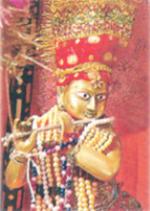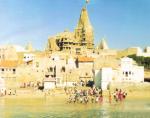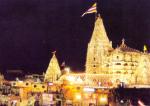The most famous spot on the west coast of Gujarat is Dwarka, a city older than the Puranas aT even the Kavyas. This city is well known, because of the great Lord Krishna whose emple is situated here and He is called Dwarkadhish. According to the legend, when the two enemies of Krishna, Jarasandh and Kalyavan attacked Mathura to revenge the killing of its earlier king and uncle of Krishna, named Kansa, to prevent the annihilation of the Yadava tribe, Lord Krishna came down to this place and named it' as Dwarka, where he set up his own kingdom. This name has a very significant meaning. We have already seen how it denotes as the Gateway to India in the west by the sea.
One of the 4 major pilgrimage sites, called Haridham, which spread all over India, this temple is situated on the northem banks of the River Gomti. Its architecture is of 13th century, similar to the other contemporary Hindu temples. It has an icon of the Lord with four hands, it has sanctum sanctorum or Garbhagriha, a large public hall called Sabhagriha and Mahamandapa.
The city that Sudama has described is not to be seen even in part or any remnants. Legend has it that when at Prabhas Patan Lord Krishna was about to die, he sent a message to the Yadavas to evacuate Dwarka, for it was destined to sink into the ocean upon his death. However, we have nothing to show for a golden city on the land anymore, for it is indeed under the sea. The present Dwarka is a new city that came up much later.
It may be that the legend is imaginary, as many are. However, it is interesting that the a marine archeologist Dr. Rao has discovered an entire urban settlement under the sea near the present Dwarka that shows signs of having beeen washed over five times by the sea.
Whatever it may be, present Dwarka is a small little town and its importance lies in its religious association. The ancients had described it as one of the seven cities where death would bring Moksha to the seekers. Chaitnaya Mahaprabhu had visited it. It is said the Meera the great saint poetess of India came here at the end of her days and was merged into the very image of Lord Krishna whom she worshipped. The pilgrimage continues without interruption. Thousands of people gather here for worship at the temple of Ranchhodji - Dwarkadhish- and offer their prayers and gifts with great faith in their hearts, as He sits benignly in the beautiful temple.
The Temple has a very high plinth and the first level is reached after climbing a number of steps. Situated right at the juncture where the Gomti meets the sea, this height and steps provide a position of haughtiness for the Lord within. The sea seems to be touching His feet all the time with its gentle waves. The central place, Garbhagriha is 60 meters high, with a 6 storied 'shikhara' or inverted cone-like structure in 6 layers. In the front of it we have a huge 'mandapa' , a hall that is 5 stories or 35 meters in height. Its corridors are 27 meters long and 6.4 meter wide. The outer walls have sculptured reliefs from its base to the top, but the insides of the wall are plain. The entrance is decorated with an image of Lord Ganesha.
Within, the 1 meter high dark colored image of Ranchhodrai or Dwarkadhish, is in a pose of Four- armed Lord Vishnu. On the first floor above is the image of Goddess Ambaji and Balaram's image is found near the Mandapa. The traditional set up of a place of pilgrimage that is followed here as well vis besides the main Temple, there are several other temples, small and big, surrounding it and provision for accommodation of pilgrims is made in 'Dharamshalas' or facilities for spending nights there.
In order to avoid meaningless mass killings, Shri Krishna came over to Gujarat with his Yadavas. The capital he set up came to be called 'Sonani Dwarka' or 'Dwarka made of Gold' and he ruled here for next 36 years.
The one who is born, dies. This is an eternal law of Nature. Dwarkadhish Krishna had a premonition about his death and what was to follow. He saw that his capital was going to be submerged into the sea soon after his death. So when he was about to expire by the injury caused by an arrow of a hunter who mistook his foot for a deer, Krishna sent a message to the Yadavas to evacuate Dwarka within a week. On seventh day the town was nearly empty and as he had foreseen, the waters of the seas entered the town and its streets and ultimately took it down into its huge underbelly. It is a wonderful story. Or has been until some time ago!
During the 1980s the research under the sea in the western coast certain things have indicated the remnants belong to circa 1500 BC, and the scholars have estimated the period of the epic of Mahabharata also at circa 1500 BC based on other sources much earlier. In the 'Sabha Parva' of Mahabharata we find reference to Raivataka Mountain being near Dwarka, but the 'Mushal Parva' mentions for the first time about Dwarika being near the Sea. The ruins found nearby this place are believed to be of 3rd century BC or so.
The temple was in existence however, when Adi Shankaracharya set up the Dwarkapith in the eastern side, next to the temple complex in late 8th century. The sixth century Garulak rulers call themselves as 'Dwarkapati' and this indicates the existence of the temple in that century. About this temple, Vishnu Purana, a forth century work, has reference. Hence it can be concluded that the temple must have existed even much earlier. The present temple with its numerous stories does not seem to be older than 400 to 500 years, though it is possible that its foundation underneath the present one could be as old as 1500 or even 2000 years old.
Shankhodhhar Bet - Bet Dwarka
At about 32 km from Dwarka is the Shankhoddhar Bet. It is also known as Bet Dwarka or Ramandvip. The legend says that Lord Krishna used to live here during his kingship of Dwarka. The main attractions of this place are the temple of Ranchhodray and Shankhoddhar. The temple is very simple and has 'haveli' like architectural features used in Pushtimarg temples. A huge compound with a wall surrounding it has 5 three-story buildings called Mahaals. The major temple here is that of Matsyavatar. It is believed that a demon called Shankh was rescued from a life of sin by Lord Krishna and the story is connected with the 'Panchajanya' Shankhasur held by Lord Krishna and Vishnu. We find that in the sea around this island a large number of conches (shankh) are produced. The present temple is supposed to have been as old as 800 years.
Saturday, October 22, 2011
Dwarkadhish Temple at Dwarka
Dwarkadhish Temple at Dwarka
Subscribe to:
Post Comments (Atom)






No comments:
Post a Comment